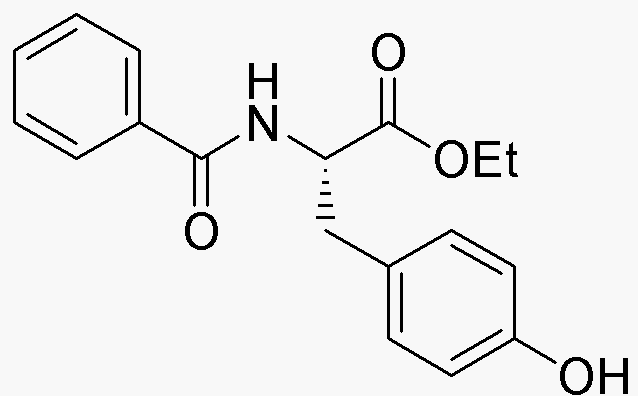Benzoyl-L-tyrosine ethyl ester is widely utilized in research focused on:
- Pharmaceutical Development: This compound serves as a precursor in the synthesis of various pharmaceuticals, particularly those targeting neurological disorders, due to its ability to cross the blood-brain barrier.
- Cosmetic Formulations: It is incorporated into skincare products for its antioxidant properties, helping to protect the skin from oxidative stress and improve overall skin health.
- Biochemical Research: Researchers use it as a model compound to study enzyme interactions and protein synthesis, aiding in the understanding of metabolic pathways.
- Food Industry: The compound is explored for its potential as a natural preservative, offering an alternative to synthetic additives while enhancing flavor profiles.
- Material Science: It is investigated for its role in developing biodegradable polymers, contributing to more sustainable materials in various applications.
Información general
Propiedades
Seguridad y normativas
Aplicaciones
Benzoyl-L-tyrosine ethyl ester is widely utilized in research focused on:
- Pharmaceutical Development: This compound serves as a precursor in the synthesis of various pharmaceuticals, particularly those targeting neurological disorders, due to its ability to cross the blood-brain barrier.
- Cosmetic Formulations: It is incorporated into skincare products for its antioxidant properties, helping to protect the skin from oxidative stress and improve overall skin health.
- Biochemical Research: Researchers use it as a model compound to study enzyme interactions and protein synthesis, aiding in the understanding of metabolic pathways.
- Food Industry: The compound is explored for its potential as a natural preservative, offering an alternative to synthetic additives while enhancing flavor profiles.
- Material Science: It is investigated for its role in developing biodegradable polymers, contributing to more sustainable materials in various applications.
Documentos
Hojas de datos de seguridad (HDS)
La SDS proporciona información de seguridad completa sobre la manipulación, el almacenamiento y la eliminación del producto.
Especificación del producto (PS)
La PS proporciona un desglose completo de las propiedades del producto, incluida la composición química, el estado físico, la pureza y los requisitos de almacenamiento. También detalla los rangos de calidad aceptables y las aplicaciones previstas del producto.
Certificados de análisis (COA)
Busque certificados de análisis (COA) ingresando el número de lote del producto. Los números de lote y de partida se pueden encontrar en la etiqueta de un producto después de las palabras "Lote" o "Lote".
Número de catálogo
Número de lote/lote
Certificados de origen (COO)
Este certificado de origen confirma el país en el que se fabricó el producto y también detalla los materiales y componentes utilizados en él y si se deriva de fuentes naturales, sintéticas u otras fuentes específicas. Este certificado puede ser necesario para cumplir con las normativas aduaneras, comerciales y regulatorias.
Número de catálogo
Número de lote/lote
Hojas de datos de seguridad (HDS)
La SDS proporciona información de seguridad completa sobre la manipulación, el almacenamiento y la eliminación del producto.
DownloadEspecificación del producto (PS)
La PS proporciona un desglose completo de las propiedades del producto, incluida la composición química, el estado físico, la pureza y los requisitos de almacenamiento. También detalla los rangos de calidad aceptables y las aplicaciones previstas del producto.
DownloadCertificados de análisis (COA)
Busque certificados de análisis (COA) ingresando el número de lote del producto. Los números de lote y de partida se pueden encontrar en la etiqueta de un producto después de las palabras "Lote" o "Lote".
Número de catálogo
Número de lote/lote
Certificados de origen (COO)
Este certificado de origen confirma el país en el que se fabricó el producto y también detalla los materiales y componentes utilizados en él y si se deriva de fuentes naturales, sintéticas u otras fuentes específicas. Este certificado puede ser necesario para cumplir con las normativas aduaneras, comerciales y regulatorias.


